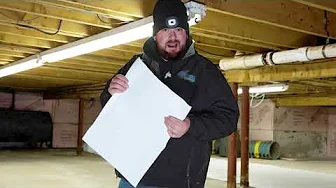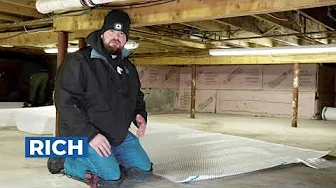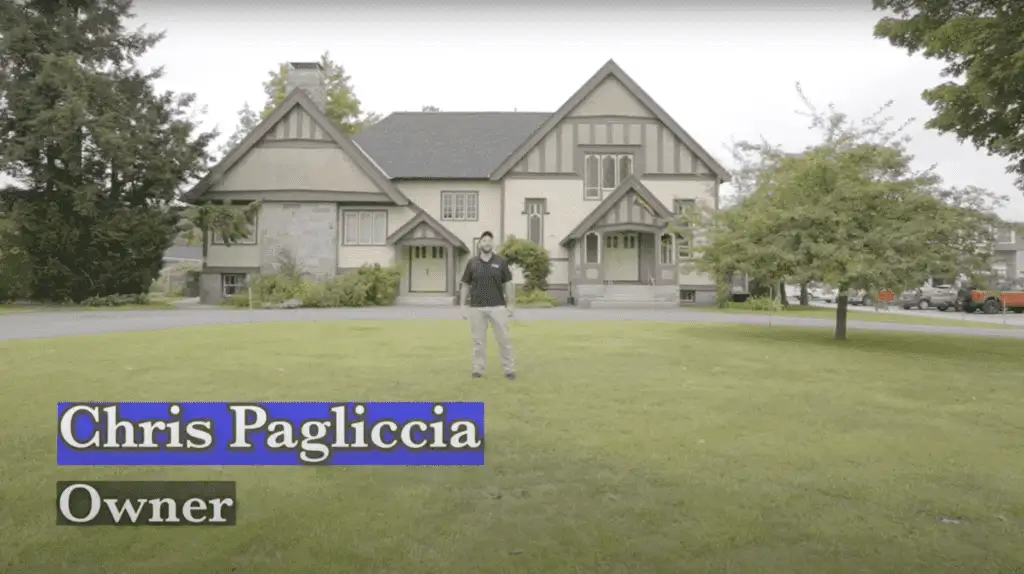Radon Mitigation Wells ME
Radon is a naturally occurring gas that is colorless, odorless, and radioactive. It forms when uranium breaks down in soil, rock, or water. While it may seem harmless, radon is the second leading cause of lung cancer in the U.S., according to the EPA. Homes and buildings in Maine, including Wells, are particularly prone to elevated radon levels because of the region’s geology. Addressing radon isn’t just about safety—it’s about taking proactive steps to live in a healthier environment.
Real People - Real Great Results
Crawl Space Video Playlist
What Is Radon?
Radon is an invisible, odorless radioactive gas that forms naturally when uranium in soil, rock, or water decays over time. While it might sound like a distant concern for geologists, radon is a household intruder. It sneaks into homes through foundation cracks, gaps around pipes, or the pores of concrete, quietly accumulating in basements and lower levels. The process is so subtle that many people never know it’s there until they test for it.
Maine’s geography, especially in towns like Wells, makes radon an even bigger issue. The state’s granite-rich bedrock contains higher-than-average amounts of uranium. As this uranium breaks down, it releases radon, which then gets trapped under homes or seeps indoors. Combine that with older housing stock in some areas, and you have a recipe for elevated radon levels. If you live in Wells, ME, chances are your property’s radon risk is higher than the national average—it’s worth addressing before it becomes a long-term health hazard.
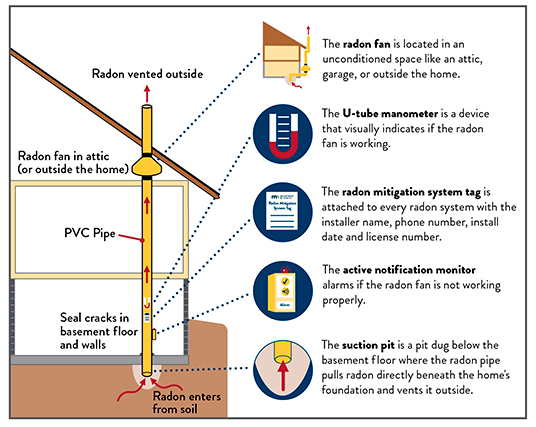
Health Risks Associated With Radon
Radon is a quiet, invisible intruder that chips away at your health over time. Once it seeps into your home, it can accumulate in the air you breathe, and that’s where the real danger begins. Prolonged exposure to radon is the second leading cause of lung cancer in the United States, according to the Environmental Protection Agency (EPA). For smokers, the risk skyrockets, but here’s the kicker: non-smokers are far from safe. In fact, the EPA estimates that more than 20,000 lung cancer deaths each year are linked to radon exposure—many of them affecting those who’ve never lit a cigarette in their life.
The connection between radon and lung cancer isn’t a scare tactic; it’s a hard, statistical reality. As radon is inhaled, the radioactive particles it emits can lodge deep in your lungs. Over time, this causes damage to lung tissues, leading to mutations that can eventually develop into cancer. Unlike an open flame or a carbon monoxide leak, radon doesn’t announce its presence with immediate symptoms. The danger builds quietly, often undetected, over years or even decades.
Safe radon levels, as defined by the EPA, are below 4 picocuries per liter (pCi/L). However, even levels between 2 and 4 pCi/L pose some risk. The lower, the better—no level of radon is completely free of danger. When living in regions like Wells, Maine, where radon levels are often naturally elevated due to geological factors, testing your home becomes a non-negotiable step in protecting your health. Waiting or assuming your home is safe simply isn’t worth the gamble.
Detecting Radon in Homes in Wells, ME
If you live in Wells, ME, and haven’t tested your home for radon, it’s time to change that. Here’s the thing: radon doesn’t announce its presence. It doesn’t smell, you can’t see it, and you can’t feel it creeping into your home. The only way to know if it’s there is to test for it. In Maine, where the geology makes radon more of a threat, this is not something you can afford to ignore.
Testing for radon can be as quick or as thorough as you need, depending on the situation. Short-term radon tests, which typically run between 2 and 90 days, are a good starting point and are widely available—hardware stores, online retailers, even some local government programs might offer kits. Long-term tests, stretching over three months to a year, paint a fuller picture of your home’s radon levels by accounting for seasonal fluctuations.
The process itself sounds like something out of a spy manual but is surprisingly simple. Short-term kits typically involve placing a small device (usually a charcoal-based collector or an electronic monitor) in a low-traffic area like the basement or first floor for a set period. Once the test is complete, you send the device to a lab and wait for the results— piece of cake, really.
For those in Wells, it’s worth emphasizing that radon testing isn’t a “one-and-done” deal. Even homes that test low today could develop problems over time due to settling foundations, renovations, or changing environmental factors. If you haven’t checked your home in a few years or if you’re buying a new property, consider it a priority. You’re testing for more than just numbers on a report—you’re testing for peace of mind.
Need a nudge? The EPA recommends taking action if levels hit 4 pCi/L or higher, but even lower levels can pose risks over long periods. This isn’t about overreacting; it’s about staying ahead of the curve in a state where radon isn’t just a possibility—it’s a reality.
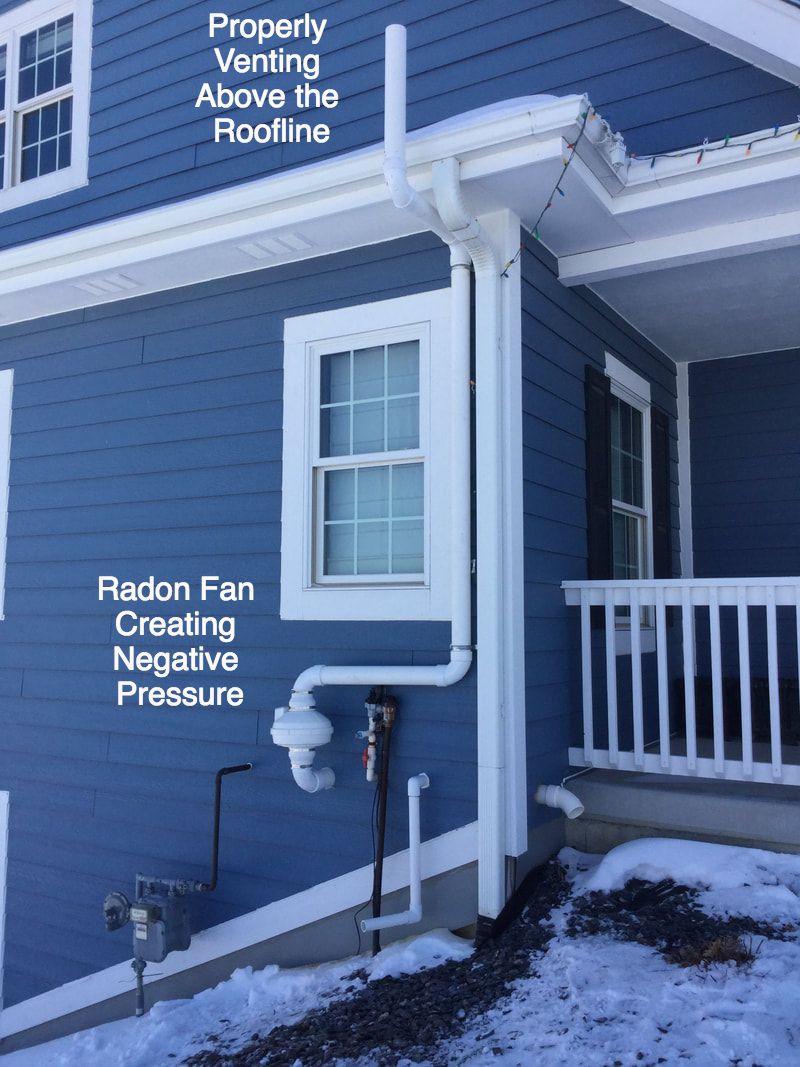
What Is Radon Mitigation?
Radon mitigation is the process of reducing radon gas levels within a building to minimize health risks. Since radon is both colorless and odorless, its presence can go unnoticed without testing. Once elevated levels are confirmed, mitigation systems are designed to actively vent the gas out of the home, preventing it from accumulating to dangerous concentrations.
The most common radon mitigation system involves sub-slab depressurization. This method creates a pathway for radon beneath the foundation, using pipes and a specialized fan to draw the gas from the soil and release it safely above the roofline, far from windows or other openings. Other systems might target specific problem areas, such as crawl spaces, where membranes and piping are used in tandem to achieve a similar venting effect.
Radon mitigation isn’t a DIY job. For any system to work effectively, it needs to be correctly installed, tested, and tailored to your home’s unique design. Hiring a licensed radon mitigation professional ensures not only successful installation but also compliance with state guidelines and EPA recommendations. In Wells, ME, where higher radon levels are common, this step is critical to creating a healthier indoor environment.
Common Radon Mitigation Systems in ME
When it comes to keeping radon in check, Maine homeowners have several effective mitigation options tailored to the region’s unique housing structures and geological quirks. Each system has a specific use case and method of reducing radon levels to below EPA-recommended thresholds. Here’s a breakdown of the most common systems:
Sub-Slab Depressurization
The go-to method for radon mitigation, sub-slab depressurization works by creating an active venting system beneath your home’s foundation. A PVC pipe is installed beneath the concrete slab, drawing radon gas from the soil and channeling it safely outdoors through an exhaust fan. Think of it as intercepting the gas before it ever has a chance to seep into the home. For properties in Wells, where granite-heavy geology can contribute to radon, this is often the most effective solution. It’s straightforward, efficient, and works in most homes with a traditional slab foundation.
Drain-Tile Suction Systems
If your home already has perimeter drain tiles (commonly found in places with wet basements), a drain-tile suction system could be a natural fit. This system pulls radon from the drain tiles and directs it outside, doubling as both a radon mitigation solution and a way to manage moisture. While not every Wells house has drain tiles in place, for homes that do, it’s a no-brainer option.
Crawl Space Solutions
For homes with crawl spaces—a common feature in some older properties—special accommodations are necessary. Sealing the crawl space with a durable barrier (like polyethylene sheeting) and pairing it with venting or suction techniques ensures radon is controlled at the source. The key here is to prevent gas from accumulating in that vulnerable, hard-to-reach area. While sealing alone isn’t enough, combining it with an active mitigation system can significantly lower radon concentrations.
In Wells, radon mitigation often comes down to understanding the house’s structure and soil conditions. An experienced professional can recommend the best system to ensure your home stays safe for years to come.
Why Radon Mitigation is Essential for Homes in Wells, ME
Wells, Maine, isn’t just known for its picturesque coastline and charming New England homes—it’s also sitting on a bed of granite-rich soil that can make radon levels uncomfortably, and dangerously, high. This geological reality means radon isn’t just a possible issue here—it’s a probable one. Without proactive mitigation, families living in Wells are at heightened risk of exposure to this silent carcinogen. It’s like playing poker with your lungs as the gamble.
But the stakes aren’t just personal health. When you install a radon mitigation system, you’re not only lowering your risk of lung cancer—you’re also boosting the value of your property. For potential buyers, seeing that you’ve already taken care of radon concerns is a tangible sign of care and foresight. It’s one less thing for them to worry about, and that can make your home more marketable in the long run. So, whether you’re planning to stay for decades or you’re eyeing a future sale, radon mitigation is both a smart and safe investment.
Mitigation in Wells isn’t just a precaution—it’s practically a requirement. Local geology isn’t changing anytime soon, and neither is the health threat posed by radon. But with the right system in place, you can reclaim control over your living environment, ensuring peace of mind for you and your family.
Steps To Take After Discovering Radon in Your Home
1. Confirm Levels: Finding elevated radon levels during a short-term test can be unsettling, but don’t panic. These tests are just a snapshot of the situation, and radon concentrations can fluctuate. The next step is to conduct a long-term test, which usually lasts 90 days or more. Long-term results provide a more accurate reflection of the radon levels in your home over time. Kits are widely available, but if in doubt, professional assistance always adds clarity.
2. Consult a Professional: Once you have confirmed elevated radon levels, it’s time to involve the pros. Radon mitigation isn’t a DIY job—consulting a licensed radon mitigation expert in Maine ensures a solution tailored to your home. These specialists assess your property’s structure, pinpoint the radon entry points, and recommend the most effective system. In Maine, where homes vary from basements to crawl spaces, you need expertise that understands the local architectural quirks and geological tendencies.
3. Mitigation Installation: The good news? Radon mitigation systems work, and they work well. Most systems are straightforward to install, non-invasive, and won’t require major reconstruction of your home. The most common systems—like sub-slab depressurization—actively vent radon out before it can seep into your living spaces. Within a few days of installation, you’ll already see reduced levels, giving you peace of mind. And while installation day might sound like a hassle, homeowners in Wells are often surprised by how smoothly the process goes with the right professionals.
Taking these steps after discovering radon is not just about addressing an immediate concern; it’s a long-term investment in your health and safety.

Maintaining Your Radon Mitigation System
Once you’ve taken the vital step of installing a radon mitigation system, the work isn’t entirely done. Like any home system, regular maintenance is crucial to ensure its continued effectiveness. After all, no one wants to assume they’re safe only to find their system isn’t working as intended.
First and foremost, schedule annual inspections. These checkups will verify that the key components—such as the fan and the vent pipes—are functioning correctly, free of blockages, and maintaining proper airflow. A professional inspector can also assess whether any updates or adjustments are necessary due to changes in your home or environmental conditions.
Periodic radon re-testing should also be a non-negotiable part of your home maintenance routine. Even the best systems can see shifts in efficiency over time. Experts recommend testing at least every two years, though you might consider more frequent testing in high-risk areas like Wells, ME. Testing kits are affordable and straightforward to use, giving you peace of mind without much hassle.
Finally, keep an eye on visible components of the system, such as sealed cracks, pipes, and the manometer (if your system has one). If you notice any unusual signs—like the fan making odd noises or the manometer levels shifting unexpectedly—act quickly to investigate the issue. Small problems can escalate if left unchecked, so don’t brush off what might seem like minor concerns.
The key to radon mitigation isn’t just installing a system; it’s committing to the habits that keep it working at peak performance. Regular attention, even if minimal, can mean the difference between a reliably safe home and one unknowingly at risk. Keep up with the maintenance—it’s worth it.
Frequently Asked Questions About Radon Mitigation in Wells, ME
1. How much does radon mitigation cost in Maine?
The cost of radon mitigation systems in Maine typically ranges from $800 to $2,500. The price can vary depending on the size and layout of your home, the type of foundation, and the complexity of the installation. Houses with crawl spaces or unique structural challenges may fall closer to the higher end of this spectrum. While the upfront cost might seem steep, it’s an investment in both health and peace of mind.
2. Will mitigation lower radon levels permanently?
Radon mitigation systems are highly effective at significantly lowering radon levels, but they’re not set-it-and-forget-it solutions. These systems reduce radon by venting gas outside, bypassing your home entirely. That said, ongoing maintenance and occasional re-testing are important to ensure the system continues to work effectively over time. Radon levels can fluctuate, particularly with changes in weather and soil conditions, so staying proactive is key.
3. How long does it take to install a radon mitigation system?
Most radon mitigation systems can be installed in a single day, often within 4–8 hours. The exact timeframe will depend on the type of system and the specifics of your home. A professional installer will typically assess your property beforehand, so there are no surprises during installation. The process is straightforward and minimally invasive, meaning you can often carry on with your day while the work is completed.
Conclusion
Radon is an invisible, silent danger—easy to overlook, but impossible to ignore once you understand the risks. In Wells, ME, where geological conditions make elevated radon levels more common, tackling this issue isn’t optional; it’s essential. Testing your home is the first step to protecting your family, and mitigation systems are a straightforward, effective solution to ensure the air inside your home is as clean as it should be. The investment you make in addressing radon isn’t just for today—it’s a promise of health and safety for the people you care about, now and in the future. Sometimes, prevention is the most powerful form of protection.
Reviews from Happy Customers
Our top priority is customer satisfaction, and we work closely with clients to understand their unique needs and goals.




